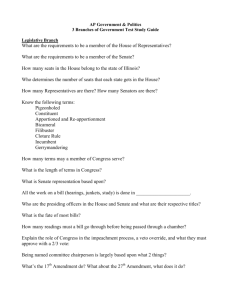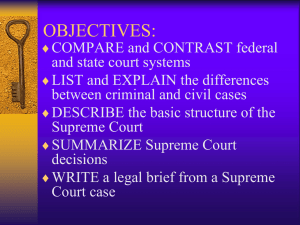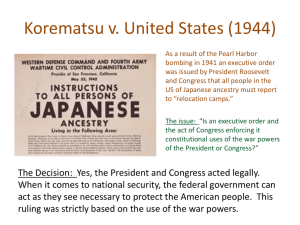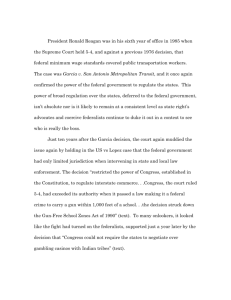V. Women and Equal Rights
advertisement
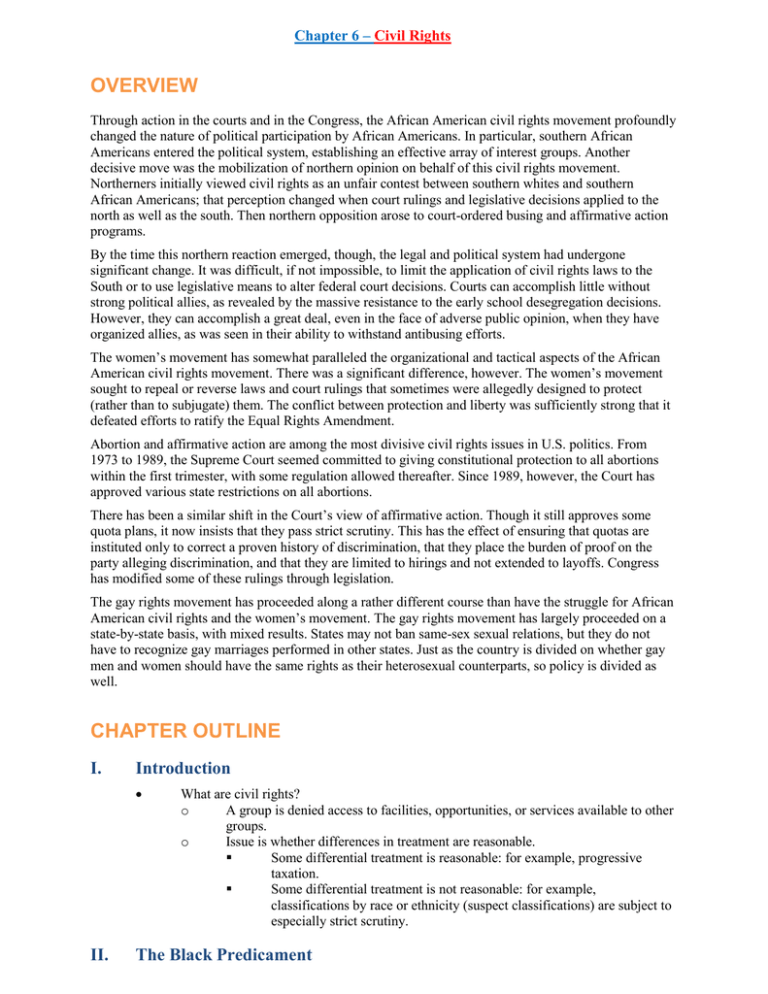
Chapter 6 – Civil Rights OVERVIEW Through action in the courts and in the Congress, the African American civil rights movement profoundly changed the nature of political participation by African Americans. In particular, southern African Americans entered the political system, establishing an effective array of interest groups. Another decisive move was the mobilization of northern opinion on behalf of this civil rights movement. Northerners initially viewed civil rights as an unfair contest between southern whites and southern African Americans; that perception changed when court rulings and legislative decisions applied to the north as well as the south. Then northern opposition arose to court-ordered busing and affirmative action programs. By the time this northern reaction emerged, though, the legal and political system had undergone significant change. It was difficult, if not impossible, to limit the application of civil rights laws to the South or to use legislative means to alter federal court decisions. Courts can accomplish little without strong political allies, as revealed by the massive resistance to the early school desegregation decisions. However, they can accomplish a great deal, even in the face of adverse public opinion, when they have organized allies, as was seen in their ability to withstand antibusing efforts. The women’s movement has somewhat paralleled the organizational and tactical aspects of the African American civil rights movement. There was a significant difference, however. The women’s movement sought to repeal or reverse laws and court rulings that sometimes were allegedly designed to protect (rather than to subjugate) them. The conflict between protection and liberty was sufficiently strong that it defeated efforts to ratify the Equal Rights Amendment. Abortion and affirmative action are among the most divisive civil rights issues in U.S. politics. From 1973 to 1989, the Supreme Court seemed committed to giving constitutional protection to all abortions within the first trimester, with some regulation allowed thereafter. Since 1989, however, the Court has approved various state restrictions on all abortions. There has been a similar shift in the Court’s view of affirmative action. Though it still approves some quota plans, it now insists that they pass strict scrutiny. This has the effect of ensuring that quotas are instituted only to correct a proven history of discrimination, that they place the burden of proof on the party alleging discrimination, and that they are limited to hirings and not extended to layoffs. Congress has modified some of these rulings through legislation. The gay rights movement has proceeded along a rather different course than have the struggle for African American civil rights and the women’s movement. The gay rights movement has largely proceeded on a state-by-state basis, with mixed results. States may not ban same-sex sexual relations, but they do not have to recognize gay marriages performed in other states. Just as the country is divided on whether gay men and women should have the same rights as their heterosexual counterparts, so policy is divided as well. CHAPTER OUTLINE I. Introduction II. What are civil rights? o A group is denied access to facilities, opportunities, or services available to other groups. o Issue is whether differences in treatment are reasonable. Some differential treatment is reasonable: for example, progressive taxation. Some differential treatment is not reasonable: for example, classifications by race or ethnicity (suspect classifications) are subject to especially strict scrutiny. The Black Predicament III. Many whites felt deeply threatened by African American integration and political action. o Sense of threat was particularly strong in places where African Americans were a majority (i.e., Deep South). o In the North, African American gains often appeared to come at the expense of lower-income whites. o Change was even more difficult because African Americans were not able to vote in many areas and often lacked the resources for effective political organizing. Racism produced some appalling situations. o Approximately 3,600 blacks were lynched; this shocked some whites, but little was done. o Even in states where blacks voted, popular attitudes did not allow them to buy homes or take jobs on an equal basis with whites. o Popular opinion was strongly against school integration and integration of public transportation. Progress depended on at least one of two things: o finding more white allies; and o shifting to policy-making arenas where whites had less of an advantage. Civil rights movement did both. o It broadened the base by publicizing the denial to African Americans of essential, widely accepted liberties. o It moved the legal and political struggle of Africa Americans from Congress to the federal courts. The Campaign in the Courts (THEME A: CIVIL RIGHTS AND THE COURTS) Ambiguities in the Fourteenth Amendment o Broad interpretation: The Constitution is color blind, so no differential treatment is acceptable. o Narrow interpretation: Equal legal rights, but African Americans and whites could otherwise be treated differently. o Supreme Court adopted narrow view in Plessy v. Ferguson (1896). A. “SEPARATE BUT EQUAL” B. CAN SEPARATE SCHOOLS BE EQUAL? C. NAACP campaign relied on courts; litigation didn’t require broad coalitions or changing public opinion. NAACP strategy went through a series of stages: o First, persuade the Supreme Court to declare unconstitutional the laws creating schools that were separate but obviously unequal; o then persuade the Supreme Court to declare unconstitutional the laws creating schools that were separate but not so obviously unequal; and o Finally, have the Supreme Court rule that separate schools are inherently unequal and therefore unconstitutional Step 1: Determining obvious inequalities, addressed in 1938–48 cases o Lloyd Gaines (law school, Missouri) o Ada Lois Sipuel (University of Oklahoma Law School) Step 2: Deciding that separation creates inequality in less obvious cases o Heman Sweatt (University of Texas Law School) o George McLaurin (University of Oklahoma PhD program) Step 3: Declaring that separation is inherently unequal—Brown v. Board of Education (neighborhood schools, Topeka, Kansas) BROWN V. BOARD OF EDUCATION (1954) Unanimous Supreme Court opinion overturned Plessy 1. IMPLEMENTATION 2. THE RATIONALE 3. Segregation is detrimental; it creates a sense of inferiority in African American students. Relied on social science because the Fourteenth Amendment was not necessarily intended to abolish segregated schools and the Court sought a unanimous opinion DESEGREGATION VERSUS INTEGRATION IV. Class action suit that applied to all similarly situated African American children Local federal district courts were to implement the decisions. “All deliberate speed” met great resistance. Southern Manifesto condemned Brown as “abuse of judicial power.” Resistance did not collapse until the 1970s. De jure (South) and de facto (North) segregation 1968 rejection of “freedom of choice” plan because it did not produce a unitary, nonracial system of education Charlotte-Mecklenburg (1971): Set guidelines for subsequent school integration cases. o Plaintiff must show school system’s intent to discriminate. o Continued existence of segregated schools in district with history of segregation creates presumption of intent to discriminate. o Remedies may include racial quotas, redrawn district lines, and court-ordered busing. o Not every school needs to reflect the composition of the district as a whole. Intercity busing could be authorized only if both the city and the suburbs had practiced segregation. Importance of intent meant that the Supreme Court would not constantly redraw district lines or bus routes. Problems: o White flight may create single-race schools. o Integrated schools are usually found in integrated neighborhoods and quality school systems. Busing remained controversial. o Presidents Nixon, Ford, and Reagan opposed busing. o Congress was unable to pass meaningful legislation; issue had died by late 1980s. In 1992decision, busing allowed to end if segregation was caused solely by segregated housing patterns. The Campaign in Congress Strategy was to get issues on the political agenda by mobilizing opinion through dramatic events. o Sit-ins and freedom rides, voter-registration efforts o Martin Luther King, Jr., Rosa Parks—Montgomery bus boycott o From nonviolent civil disobedience to the “long, hot summers” of racial violence (1964–68) Mixed results o Agenda-setting success o Coalition-building setbacks because many whites saw demonstrations and riots as law-breaking Legislative politics o Opponents had strong defensive positions o o o o A. RACIAL PROFILING V. Senate Judiciary Committee controlled by southern Democrats House Rules Committee controlled by Howard Smith (Virginia) Senate filibuster threat President Kennedy reluctant to submit strong civil rights legislation Four developments broke this deadlock Public opinion changed regarding school integration and access to public facilities. Violent reactions of segregationists received extensive coverage by the media. Kennedy assassination—November 22, 1963 Democratic landslide in 1964 allowed northern Democrats to prevail in Congress. Five bills pass, 1957–68 1957, 1960, 1965: Voting rights laws 1968: Housing discrimination law 1964 Civil Rights Act: The high point—employment, public accommodations, voting, schools Since 1960s, mood of Congress has shifted and is now supportive of civil rights legislation. Change in congressional response reflects both dramatic rise in African American voting and change in white elite opinion. Racial Profiling: The condition in which law enforcement authorities are more likely to stop and question people because of their race or ethnicity (for example, “driving while black”) o Opponents: Racial profiling is inherently discriminatory and should never be practiced o Alternative perspective: Perhaps members of some groups are more likely to break the law; stopping innocent people may lead to higher levels of public safety. o Terrorist attacks of 9/11 further heightened the debate and the stakes. Currently have insufficient data to understand how police make their judgments, so that those judgments will balance safety and rights Women and Equal Rights (THEME B: WOMEN AND EQUAL RIGHTS) Seneca Falls Convention (1848): Beginning of the women’s rights movement; leaders demanded the right to vote o Several states (particularly in the West) granted women the franchise. o The Nineteenth Amendment—passed in 1920—made clear that no one could be denied the right to vote on the basis of sex Great change took place during World War II: Large-scale female employment in nontraditional jobs in the defense industry HOW THINGS WORK—How the Court Decides If You Discriminate o In the 1970s, Supreme Court began to review gender-based classifications and had to determine what standards to employ. Three standards based on the circumstances of a case—Court applies three tests to determine if a government policy violates the Constitution: Rational basis: If the policy uses reasonable means to achieve a legitimate government goal, it is constitutional. An example would include prohibition of drinking until a person reaches age 21. Intermediate scrutiny: If the policy serves an important government interest and it is “substantially related” to that interest, it is constitutional. The age at which men can be o punished for statutory rape differs from that of women because men and women are not “similarly situated.” Strict scrutiny: Discriminatory action must serve a “compelling government interest” and be “narrowly tailored” to attain that interest, using the “least restrictive mean” to attain it. Examples: Distinctions based on race, ethnicity, religion or voting must pass the strict scrutiny test. Black children must be allowed to attend public schools, and black adults must be allowed to vote. Supreme Court chooses a blend of these. 1. ILLEGAL DISCRIMINATION 2. DECISIONS ALLOWING DIFFERENCES BASED ON SEX B. Gender-based differences allowed by courts: o Statutory rape o All-boy/all-girl public schools o Widows’ property tax exemption o Delayed promotions in navy Virginia Military Institute (VMI) case came close to imposing strict scrutiny test The draft o Rostker v. Goldberg (1981): Congress may require men but not women to register for the draft o In 1993, secretary of defense allowed women in air and sea combat positions, but not in ground combat positions. SEXUAL HARASSMENT C. Gender-based differences have been prohibited by the courts in regard to these issues: o Age of legal adulthood o Drinking age o Arbitrary employee height-weight requirements o Mandatory pregnancy leaves o Little League exclusion o Business and professional associations o Retirement benefits o Salaries for high school coaches of girls and boys Two forms: o Quid pro quo rule: Sexual favors required as a condition for holding a job or for promotion; employers are strictly liable o Hostile environment: Creating a setting in which harassment impairs a person’s ability to work; employers liable if they were negligent Supreme Court position continues to evolve, and standards are not yet clearly articulated. o Determined that school system was not liable for conduct of teacher who seduced a student because the student did not report the actions. o A city was liable for sexually hostile work environment, even though employee did not report this to superiors. o Female employee who was not promoted after rejecting sexual advances of her boss could recover financial damages from the firm. PRIVACY AND SEX Regulating sexual matters traditionally a state function, under the exercise of the police powers o States traditionally decided whether and under what circumstances abortion could be obtained. o VI. New York allowed abortions during first twenty-four weeks of pregnancy; Texas banned abortion except when mother’s life was threatened. In 1965, Supreme Court held that states could not prevent sale of contraceptives because that violated the zone of privacy. o Privacy is not explicitly mentioned in Constitution. o Privacy is inferred from various provisions in Bill of Rights. 1973: Roe v. Wade o Struck down Texas ban on abortion and all similar state laws o Woman’s freedom to choose is protected by the Fourteenth Amendment. First trimester: No regulations Second trimester: No ban but regulations to protect health of woman Third trimester: Abortion ban is possible. o Critics claimed life begins at conception. Fetus is a person entitled to equal protection guaranteed by Fourteenth Amendment. Right-to-life, pro-life position o Supporters said no one can know when life begins—right to choose, prochoice position. o Constitutional amendments to overturn Roe did not pass Congress. o Hyde amendment (1976): No federal funds for abortion except when woman’s life endangered 1973–89: Supreme Court withstood attacks on Roe v. Wade. Webster (1989): Court upheld some restrictions on abortions. Casey decision (1992) does not overturn Roe but permits more restrictions: Twenty-four-hour wait, parental consent, pamphlets about alternatives; provision for husband’s consent was struck down. “Partial-birth” abortion ban was struck down in 2000, but upheld in 2007. Struggle over abortion law has recently involved public demonstrations and violence. o Courts must balance the right to protest and a clinic’s right to function. o Court has upheld orders that forbid acts of physical obstruction and that provide a buffer zone of fifteen feet around clinic entrances. Affirmative Action A. EQUALITY OF RESULTS B. Racism and sexism can be overcome only by taking them into account in designing remedies. Equal rights are not enough; people need benefits. Affirmative action—preferential hiring practices—should be used in hiring. Women should be given material necessities, such as free daycare, that will help them enter the workforce. Position is generally justified in the name of diversity or multiculturalism. EQUALITY OF OPPORTUNITY Reverse discrimination occurs when race or sex is used as a basis for preferential treatment. Laws should be color blind and gender neutral. Government should only eliminate barriers. Issue has been fought out in the courts. o No clear direction in Court decisions o Court is deeply divided—affected by conservative Reagan appointees. o Law is complex and confusing. Bakke (1978): Numerical minority quotas are not permissible, but race could be considered. o o However, Supreme Court upheld federal rule that set aside 10 percent of all federal construction contracts for minority-owned firms (1980). In 1989, Court overturned Virginia law that set aside 30 percent of construction contracts for minority firms. In 1990, Court upheld federal rule that gave preference to minority-owned firms in awarding broadcast licenses. Emerging standards for quotas and preference systems Quota system subjected to strict scrutiny—must be a compelling state interest to justify quotas Must correct an actual pattern of discrimination Must identify actual practices that discriminate Federal quotas will be given deference because the Constitution gives Congress greater power to correct the effects of racial discrimination. Voluntary preference systems may be easier to justify. Not likely to apply to persons who get laid off Compensatory action (helping minorities catch up) versus preferential treatment (giving minorities preference, applying quotas) Public supports compensatory action but not preferential treatment In line with U.S. political culture Support for individualism Support for the needy Adarand Constructors v. Pena (1995): Any racial classification is subject to strict scrutiny. Gratz v. Bollinger (2003): Overturned University of Michigan admissions policy that gave “bonus points” to black, Hispanic, and Native American applicants to the undergraduate program Grutter v. Bollinger (2003): Upheld University of Michigan Law School admissions policy that used race as a “plus factor” but not as part of a numerical quota Parents v. Seattle School District (2007): Race cannot be used to allow students to attend popular high schools because such policy is not “narrowly tailored” to achieve a “compelling” goal. VII. Gays and the Constitution Court historically willing to allow states to determine homosexual rights o Bowers v. Hardwick (1986): Georgia allowed banning homosexual sexual activity. o Right to privacy designed to protect “family, marriage or procreation” Romer v. Evans (1996): Colorado voters had adopted state constitutional amendment making it illegal to protect persons based on gay, lesbian, or bisexual orientation. o Supreme Court struck down Colorado amendment. o Colorado amendment violated equal protection clause. Lawrence v. Texas (2003): Texas law banned sexual conduct between persons of same sex. o Supreme Court overturned law. o Used same language it had used in cases involving contraception and abortion Gay marriage o Massachusetts Supreme Judicial Court decided (2003) that gays and lesbians must be allowed to marry in the state. Massachusetts legislature passed bill to reverse decision. Legislature must vote again on the matter for it to become state constitutional amendment; may not take effect until 2008. o Mayor of San Francisco issued gay/lesbian marriage licenses in defiance of state law. o In 2005, the California legislature dropped a long-standing ban prohibiting same sex marriage. The bill was vetoed by Governor Schwarzenegger. In 2008, the California Supreme Court overturned the ban. In 2008, voters in California voted to overturn the Court’s decision, in effect reinstituting the ban. This ballot decision was challenged in court as a violation of other provisions of the California Constitution. In March of 2009, the California Supreme Court upheld the constitutionality of the new law. o Under 1996 Defense of Marriage Act, no state has obligation to give legal status to same-sex marriage performed in another state. Private groups (e.g., Boy Scouts of America) still allowed to exclude homosexuals from membership. WHO GOVERNS? 1. Since Congress enacts our laws, why has it not made certain that all groups have the same rights? 2. After the Supreme Court ended racial segregation in the schools, what did the president and Congress do? TO WHAT ENDS? 1. If the law supports equality of opportunity, why has affirmative action become so important? 2. Under what circumstances can men and women be treated differently? The Black Predicament Civil Rights: The rights of people to be treated without unreasonable or unconstitutional differences. Segregated water fountains in 1939. The Campaign in the Courts “Separate but Equal” Can Separate Schools be Equal? Brown v. Board of Education • Implementation • The Rationale • Desegregation versus Integration Another Profile in Courage Dorothy Counts, the first black student to attend Harding High School in Charlotte, N.C., tries to maintain her poise as she’s taunted by shouting, gesticulating white students in September of 1957. WHAT WOULD YOU DO? MEMORANDUM To: Justice Robert Gilbert From: Ella Fitzgerald, law clerk Until school segregation ended, southern blacks could attend only all-black colleges. Now they are free to apply to previously all-white colleges, and these schools are integrated. But the traditional black colleges still exist, and very few whites apply to them. In 1992, the Supreme Court held that the state could not solve the problem by requiring a race-neutral admissions policy. Now the Court must decide whether a predominantly black college can receive state support. Arguments for all-black colleges: 1. These schools have a long tradition that ought to be preserved. 2. Many black students will learn better in an all-black environment. 3. African American organizations, in particular the United Negro College Fund, raise money for these schools. Arguments against all-black colleges: 1. If the state once required single-race schools, it now has an obligation to dismantle them. 2. Race is a suspect classification, and no state program that chiefly serves one race can be allowed. Your decision: Allow all-black colleges? Ban all-black colleges? Implementation Problems In 1963, Governor George Wallace of Alabama stood in the doorway of the University of Alabama to block the entry of black students. Facing him is U.S. Deputy Attorney General Nicholas Katzenbach. Steve Shapiro/Black Star Desegregation Versus Integration Antibusing protesters buried a school bus (unoccupied) to dramatize their cause. The Campaign in Congress Civil Disobedience In 1960, black students from North Carolina Agricultural and Technical College staged the first “sit-in” when they were refused service at a lunch counter in Greensboro (left). Twenty years later, graduates of the college returned to the same lunch counter (right). Though prices had risen, the service had improved. This picture of a police dog lunging at a black man during a racial demonstration in Birmingham, Alabama, in May 1963 was one of the most influential photographs ever published. It was widely reprinted throughout the world and was frequently referred to in congressional debates on the civil rights bill of 1964. Martin Luther King, Jr., delivers his “I have a Dream” speech on the Washington, D.C., mall in 1963. . Sources: Congressional Quarterly, Congress and the Nation, vols. 1, 2, 3, 7, 8. Sources: Statistical Abstract of the United States, 2003, table 417. Racial Profiling Two Issues Involved: • Stopping and questioning people because of their race or ethnicity with no other indications of illegal activity present • Results of the RAND Corporation study of Oakland, California police stops Women and Equal Rights Supreme Court standards • Reasonableness • Intermediate scrutiny • Strict scrutiny Illegal discrimination Decisions allowing differences based on sex Sexual harassment Privacy and sex U.S. Supreme Court Cases Related To Sexual Classification U.S. Supreme Court Cases Related To Privacy and Abortion Affirmative Action Equality of Results – Making certain that people achieve the same result Reverse discrimination – Using race or sex to give preferential treatment to some people Equality of Opportunity – Giving people an equal chance to succeed A protest in Georgia over immigration laws. U.S. Supreme Court Cases Related To Affirmative Action U.S. Supreme Court Cases Related To Gay Rights Gays and the Constitution Bowers v. Hardwick Colorado constitutional amendment Lawrence v. Texas Defense of Marriage Act People on both sides of the gay marriage issue gather in front of a California court while it considers arguments about a voter-backed ban on same-sex marriage.

